# 二、在 Eager 模式中使用指標
大家好! 在本教程中,我們將學習如何使用各種指標來評估在 TensorFlow 中使用 Eager 模式時神經網絡的表現。
我玩了很久 TensorFlow Eager 模式,我喜歡它。對我來說,與使用聲明模式相比,API 看起來非常直觀,現在一切看起來都更容易構建。 我現在發現的主要不便之處(我使用的是 1.7 版)是使用 Eager 模式時,`tf.metrics`還不兼容。 盡管如此,我已經構建了幾個函數,可以幫助你評估網絡的表現,同時仍然享受憑空構建網絡的強大之處。
教程步驟:
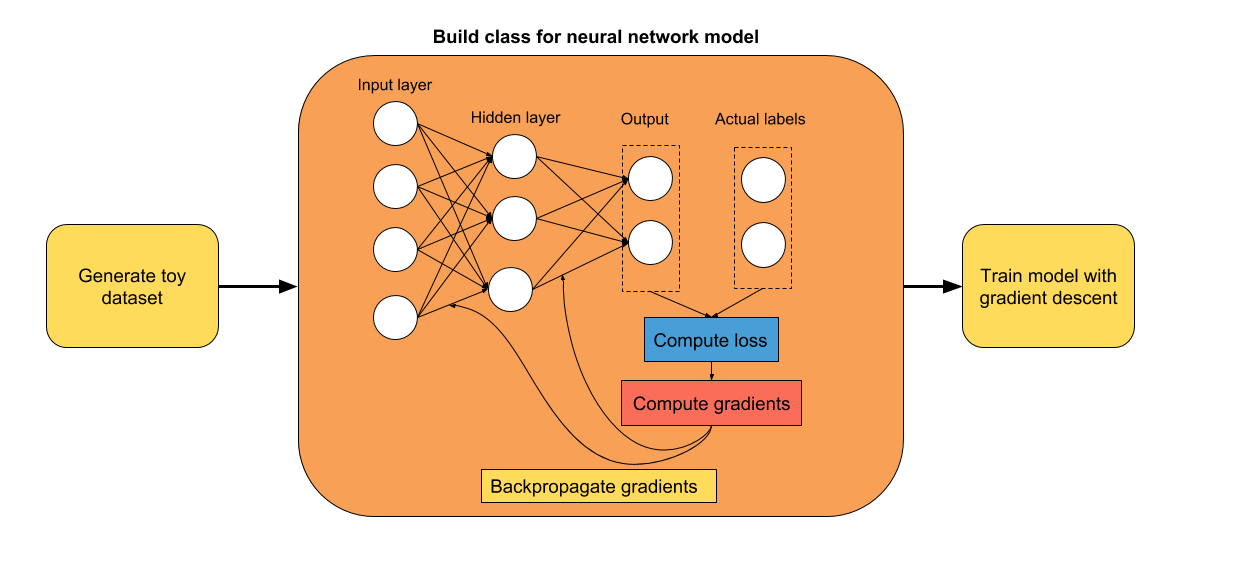
我選擇了三個案例:
多分類
對于此任務,我們將使用準確率,混淆矩陣和平均精度以及召回率,來評估我們模型的表現。
不平衡的二分類
當我們處理不平衡的數據集時,模型的準確率不是可靠的度量。 因此,我們將使用 ROC-AUC 分數,這似乎是一個更適合不平衡問題的指標。
回歸
為了評估我們的回歸模型的性能,我們將使用 R ^ 2 分數(確定系數)。
我相信這些案例的多樣性足以幫助你進一步學習任何機器學習項目。 如果你希望我添加下面未遇到的任何額外指標,請告知我們,我會盡力在以后添加它們。 那么,讓我們開始吧!
TensorFlow 版本 - 1.7
## 導入重要的庫并開啟 Eager 模式
```py
# 導入 TensorFlow 和 TensorFlow Eager
import tensorflow as tf
import tensorflow.contrib.eager as tfe
# 導入函數來生成玩具分類問題
from sklearn.datasets import load_wine
from sklearn.datasets import make_classification
from sklearn.datasets import make_regression
# 為數據預處理導入 numpy
import numpy as np
# 導入繪圖庫
import matplotlib.pyplot as plt
%matplotlib inline
# 為降維導入 PCA
from sklearn.decomposition import PCA
# 開啟 Eager 模式。一旦開啟不能撤銷!只執行一次。
tfe.enable_eager_execution()
```
## 第一部分:用于多分類的的數據集
```py
wine_data = load_wine()
print('Type of data in the wine_data dictionary: ', list(wine_data.keys()))
'''
Type of data in the wine_data dictionary: ['data', 'target', 'target_names', 'DESCR', 'feature_names']
'''
print('Number of classes: ', len(np.unique(wine_data.target)))
# Number of classes: 3
print('Distribution of our targets: ', np.unique(wine_data.target, return_counts=True)[1])
# Distribution of our targets: [59 71 48]
print('Number of features in the dataset: ', wine_data.data.shape[1])
# Number of features in the dataset: 13
```
### 特征標準化
每個特征的比例變化很大,如下面的單元格所示。 為了加快訓練速度,我們將每個特征標準化為零均值和單位標準差。 這個過程稱為標準化,它對神經網絡的收斂非常有幫助。
```py
# 數據集標準化
wine_data.data = (wine_data.data - np.mean(wine_data.data, axis=0))/np.std(wine_data.data, axis=0)
print('Standard deviation of each feature after standardization: ', np.std(wine_data.data, axis=0))
# Standard deviation of each feature after standardization: [1. 1. 1. 1. 1. 1. 1. 1. 1. 1. 1. 1. 1.]
```
### 數據可視化:使用 PCA 降到二維
我們將使用 PCA,僅用于可視化目的。 我們將使用所有 13 個特征來訓練我們的神經網絡。
讓我們看看這三個類如何在 2D 空間中表示。
```py
X_pca = PCA(n_components=2, random_state=2018).fit_transform(wine_data.data)
plt.scatter(X_pca[:,0], X_pca[:,1], c=wine_data.target, cmap=plt.cm.spring)
plt.xlabel('First PCA component', fontsize=15)
plt.ylabel('Second PCA component', fontsize=15)
plt.title('Multi-classification problem', fontsize=15)
plt.show()
```
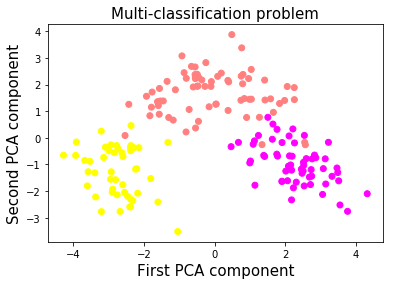
好的,所以這些類看起來很容易分開。 順便說一句,我實際上在特征標準化之前嘗試使用 PCA,粉色和黃色類重疊。 通過在降維之前標準化特征,我們設法在它們之間獲得了清晰的界限。
### 讓我們使用 TensorFlow Eager API 構建雙層神經網絡
你可能已經注意到,使用 TensorFlow Eager 構建模型的最方便方法是使用類。 我認為,為模型使用類可以更容易地組織和添加新組件。 你只需定義初始化期間要使用的層,然后在預測期間使用它們。 它使得在預測階段更容易閱讀模型的架構。
```py
class two_layer_nn(tf.keras.Model):
def __init__(self, output_size=2, loss_type='cross-entropy'):
super(two_layer_nn, self).__init__()
""" 在這里定義正向傳播期間
使用的神經網絡層
Args:
output_size: int (default=2).
loss_type: string, 'cross-entropy' or 'regression' (default='cross-entropy')
"""
# 第一個隱層
self.dense_1 = tf.layers.Dense(20, activation=tf.nn.relu)
# 第二個隱層
self.dense_2 = tf.layers.Dense(10, activation=tf.nn.relu)
# 輸出層,未縮放的對數概率
self.dense_out = tf.layers.Dense(output_size, activation=None)
# 初始化損失類型
self.loss_type = loss_type
def predict(self, input_data):
""" 在神經網絡上執行正向傳播
Args:
input_data: 2D tensor of shape (n_samples, n_features).
Returns:
logits: unnormalized predictions.
"""
layer_1 = self.dense_1(input_data)
layer_2 = self.dense_2(layer_1)
logits = self.dense_out(layer_2)
return logits
def loss_fn(self, input_data, target):
""" 定義訓練期間使用的損失函數
"""
preds = self.predict(input_data)
if self.loss_type=='cross-entropy':
loss = tf.losses.sparse_softmax_cross_entropy(labels=target, logits=preds)
else:
loss = tf.losses.mean_squared_error(target, preds)
return loss
def grads_fn(self, input_data, target):
""" 在每個正向步驟中,
動態計算損失值對模型參數的梯度
"""
with tfe.GradientTape() as tape:
loss = self.loss_fn(input_data, target)
return tape.gradient(loss, self.variables)
def fit(self, input_data, target, optimizer, num_epochs=500,
verbose=50, track_accuracy=True):
""" 用于訓練模型的函數,
使用所選的優化器,執行所需數量的迭代
"""
if track_accuracy:
# Initialize list to store the accuracy of the model
self.hist_accuracy = []
# Initialize class to compute the accuracy metric
accuracy = tfe.metrics.Accuracy()
for i in range(num_epochs):
# Take a step of gradient descent
grads = self.grads_fn(input_data, target)
optimizer.apply_gradients(zip(grads, self.variables))
if track_accuracy:
# Predict targets after taking a step of gradient descent
logits = self.predict(X)
preds = tf.argmax(logits, axis=1)
# Compute the accuracy
accuracy(preds, target)
# Get the actual result and add it to our list
self.hist_accuracy.append(accuracy.result())
# Reset accuracy value (we don't want to track the running mean accuracy)
accuracy.init_variables()
```
### 準確率指標
為了使用準確率指標評估模型的表現,我們將使用`tfe.metrics.Accuracy`類。 在批量訓練模型時,此指標非常有用,因為它會在每次調用時計算批量的平均精度。 當我們在每個步驟中使用整個數據集訓練模型時,我們將重置此指標,因為我們不希望它跟蹤運行中的平均值。
```py
# 創建輸入特征和標簽。將數據從 numpy 轉換為張量
X = tf.constant(wine_data.data)
y = tf.constant(wine_data.target)
# 定義優化器
optimizer = tf.train.GradientDescentOptimizer(5e-1)
# 初始化模型
model = two_layer_nn(output_size=3)
# 在這里選擇迭代數量
num_epochs = 5
# 使用梯度下降訓練模型
model.fit(X, y, optimizer, num_epochs=num_epochs)
plt.plot(range(num_epochs), model.hist_accuracy);
plt.xlabel('Epoch number', fontsize=15);
plt.ylabel('Accuracy', fontsize=15);
plt.title('Training accuracy history', fontsize=15);
```
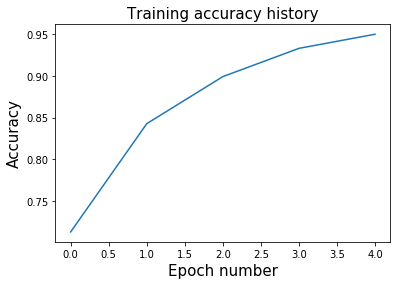
### 混淆矩陣
在訓練完算法后展示混淆矩陣是一種很好的方式,可以全面了解網絡表現。 TensorFlow 具有內置函數來計算混淆矩陣,幸運的是它與 Eager 模式兼容。 因此,讓我們可視化此數據集的混淆矩陣。
```py
# 獲得整個數據集上的預測
logits = model.predict(X)
preds = tf.argmax(logits, axis=1)
# 打印混淆矩陣
conf_matrix = tf.confusion_matrix(y, preds, num_classes=3)
print('Confusion matrix: \n', conf_matrix.numpy())
'''
Confusion matrix:
[[56 3 0]
[ 2 66 3]
[ 0 1 47]]
'''
```
對角矩陣顯示真正例,而矩陣的其它地方顯示假正例。
### 精準率得分
上面計算的混淆矩陣使得計算平均精確率非常容易。 我將在下面實現一個函數,它會自動為你計算。 你還可以指定每個類的權重。 例如,由于某些原因,第二類的精確率可能對你來說更重要。
```py
def precision(labels, predictions, weights=None):
conf_matrix = tf.confusion_matrix(labels, predictions, num_classes=3)
tp_and_fp = tf.reduce_sum(conf_matrix, axis=0)
tp = tf.diag_part(conf_matrix)
precision_scores = tp/(tp_and_fp)
if weights:
precision_score = tf.multiply(precision_scores, weights)/tf.reduce_sum(weights)
else:
precision_score = tf.reduce_mean(precision_scores)
return precision_score
precision_score = precision(y, preds, weights=None)
print('Average precision: ', precision_score.numpy())
# Average precision: 0.9494581280788177
```
### 召回率得分
平均召回率的計算與精確率非常相似。 我們不是對列進行求和,而是對行進行求和,來獲得真正例和假負例的總數。
```py
def recall(labels, predictions, weights=None):
conf_matrix = tf.confusion_matrix(labels, predictions, num_classes=3)
tp_and_fn = tf.reduce_sum(conf_matrix, axis=1)
tp = tf.diag_part(conf_matrix)
recall_scores = tp/(tp_and_fn)
if weights:
recall_score = tf.multiply(recall_scores, weights)/tf.reduce_sum(weights)
else:
recall_score = tf.reduce_mean(recall_scores)
return recall_score
recall_score = recall(y, preds, weights=None)
print('Average precision: ', recall_score.numpy())
# Average precision: 0.9526322246094269
```
## 第二部分:不平衡二分類
當你開始使用真實數據集時,你會很快發現大多數問題都是不平衡的。 例如,考慮到異常樣本與正常樣本的比例,異常檢測問題嚴重不平衡。 在這些情況下,評估網絡性能的更合適的指標是 ROC-AUC 得分。 那么,讓我們構建我們的不平衡數據集并開始研究它!
```py
XX,, yy == make_classificationmake_cla (n_samples=1000, n_features=2, n_informative=2,
n_redundant=0, n_classes=2, n_clusters_per_class=1,
flip_y=0.1, class_sep=4, hypercube=False,
shift=0.0, scale=1.0, random_state=2018)
# 減少標簽為 1 的樣本數
X = np.vstack([X[y==0], X[y==1][:50]])
y = np.hstack([y[y==0], y[y==1][:50]])
```
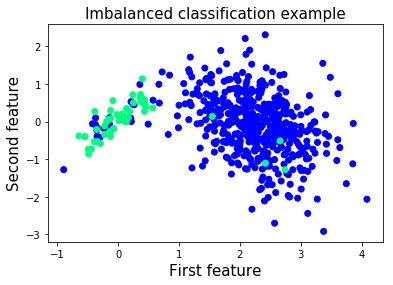
我們將使用相同的神經網絡架構。 我們只需用`num_classes = 2`初始化模型,因為我們正在處理二分類問題。
```py
# Numpy 數組變為張量
X = tf.constant(X)
y = tf.constant(y)
```
讓我們將模型只訓練幾個迭代,來避免過擬合。
```py
# 定義優化器
optimizer = tf.train.GradientDescentOptimizer(5e-1)
# 初始化模型
model = two_layer_nn(output_size=2)
# 在這里選擇迭代數量
num_epochs = 5
# 使用梯度下降訓練模型
model.fit(X, y, optimizer, num_epochs=num_epochs)
```
### 如何計算 ROC-AUC 得分
為了計算 ROC-AUC 得分,我們將使用`tf.metric.auc`的相同方法。 對于每個概率閾值,我們將計算真正例,真負例,假正例和假負例的數量。 在計算這些統計數據后,我們可以計算每個概率閾值的真正例率和真負例率。
為了近似 ROC 曲線下的面積,我們將使用黎曼和和梯形規則。 如果你想了解更多信息,請點擊[此處](https://www.khanacademy.org/math/ap-calculus-ab/ab-accumulation-riemann-sums/ab-midpoint-trapezoid/a/understanding-the-trapezoid-rule)。
### ROC-AUC 函數
```py
def roc_auc(labels, predictions, thresholds, get_fpr_tpr=True):
tpr = []
fpr = []
for th in thresholds:
# 計算真正例數量
tp_cases = tf.where((tf.greater_equal(predictions, th)) &
(tf.equal(labels, 1)))
tp = tf.size(tp_cases)
# 計算真負例數量
tn_cases = tf.where((tf.less(predictions, th)) &
(tf.equal(labels, 0)))
tn = tf.size(tn_cases)
# 計算假正例數量
fp_cases = tf.where((tf.greater_equal(predictions, th)) &
(tf.equal(labels,0)))
fp = tf.size(fp_cases)
# 計算假負例數量
fn_cases = tf.where((tf.less(predictions, th)) &
(tf.equal(labels,1)))
fn = tf.size(fn_cases)
# 計算該閾值的真正例率
tpr_th = tp/(tp + fn)
# 計算該閾值的假正例率
fpr_th = fp/(fp + tn)
# 附加到整個真正例率列表
tpr.append(tpr_th)
# 附加到整個假正例率列表
fpr.append(fpr_th)
# 使用黎曼和和梯形法則,計算曲線下的近似面積
auc_score = 0
for i in range(0, len(thresholds)-1):
height_step = tf.abs(fpr[i+1]-fpr[i])
b1 = tpr[i]
b2 = tpr[i+1]
step_area = height_step*(b1+b2)/2
auc_score += step_area
return auc_score, fpr, tpr
```
### 為我們訓練的模型計算 ROC-AUC 得分并繪制 ROC 曲線
```py
# 閾值更多意味著曲線下的近似面積的粒度更高
# 隨意嘗試閾值的數量
num_thresholds = 1000
thresholds = tf.lin_space(0.0, 1.0, num_thresholds).numpy()
# 將Softmax應用于我們的預測,因為模型的輸出是非標準化的
# 選擇我們的正類的預測(樣本較少的類)
preds = tf.nn.softmax(model.predict(X))[:,1]
# 計算 ROC-AUC 得分并獲得每個閾值的 TPR 和 FPR
auc_score, fpr_list, tpr_list = roc_auc(y, preds, thresholds)
print('ROC-AUC score of the model: ', auc_score.numpy())
# ROC-AUC score of the model: 0.93493986
plt.plot(fpr_list, tpr_list, label='AUC score: %.2f' %auc_score);
plt.xlabel('False Positive Rate', fontsize=15);
plt.ylabel('True Positive Rate', fontsize=15);
plt.title('ROC curve');
plt.legend(fontsize=15);
```
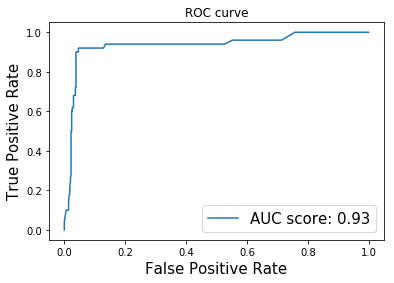
## 第三部分:用于回歸的數據集
我們最終的數據集為簡單的回歸任務而創建。 在前兩個問題中,網絡的輸出表示樣本所屬的類。這里網絡的輸出是連續的,是一個實數。
我們的輸入數據集僅包含一個特征,以便使繪圖保持簡單。 標簽`y`是實數向量。
讓我們創建我們的玩具數據集!
```py
X, y = make_regression(n_samples=100, n_features=1, n_informative=1, noise=30,
random_state=2018)
```
### 展示輸入特征和標簽
為了更好地了解我們正在處理的問題,讓我們繪制標簽和輸入特征。
```py
pltplt..scatterscatter((XX,, yy););
pltplt..xlabelxlabel(('Input''Input',, fontsizefontsize=15);
plt.ylabel('Target', fontsize=15);
plt.title('Toy regression problem', fontsize=15);
```
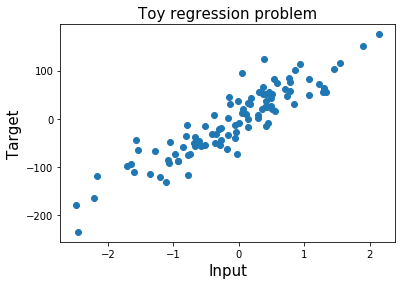
```py
# Numpy 數組轉為張量
X = tf.constant(X)
y = tf.constant(y)
y = tf.reshape(y, [-1,1]) # 從行向量變為列向量
```
### 用于回歸任務的神經網絡
我們可以重復使用上面創建的雙層神經網絡。 由于我們只需要預測一個實數,因此網絡的輸出大小為 1。
我們必須重新定義我們的損失函數,因為我們無法繼續使用`softmax`交叉熵損失。 相反,我們將使用均方誤差損失函數。 我們還將定義一個新的優化器,其學習速率比前一個更小。
隨意調整迭代的數量。
```py
# 定義優化器
optimizer = tf.train.GradientDescentOptimizer(1e-4)
# 初始化模型
model = two_layer_nn(output_size=1, loss_type='regression')
# 選擇迭代數量
num_epochs = 300
# 使用梯度下降訓練模型
model.fit(X, y, optimizer, num_epochs=num_epochs,
track_accuracy=False)
```
### 計算 R^2 得分(決定系數)
如果你曾經處理過回歸問題,那么你可能已經聽說過這個得分。
這個指標計算輸入特征與目標之間的變異百分率,由我們的模型解釋。R^2 得分的值范圍介于 0 和 1 之間。R^2 得分為 1 意味著該模型可以進行完美的預測。 始終預測目標`y`的平均值,R^2 得分為 0。
R^2 可能為的負值。 在這種情況下,這意味著比起總是預測目標變量的平均值的模型,我們的模型做出更糟糕的預測。
由于此度量標準在 TensorFlow 1.5 中不易獲得,因此在 Eager 模式下運行時,我在下面的單元格中為它創建了一個小函數。
```py
# 計算 R^2 得分
def r2(labels, predictions):
mean_labels = tf.reduce_mean(labels)
total_sum_squares = tf.reduce_sum((labels-mean_labels)**2)
residual_sum_squares = tf.reduce_sum((labels-predictions)**2)
r2_score = 1 - residual_sum_squares/total_sum_squares
return r2_score
preds = model.predict(X)
r2_score = r2(y, preds)
print('R2 score: ', r2_score.numpy())
# R2 score: 0.8249999999348803
```
### 展示最佳擬合直線
為了可視化我們的神經網絡的最佳擬合直線,我們簡單地選取`X_min`和`X_max`之間的線性空間。
```py
# 創建 X_min 和 X_max 之間的數據點來顯示最佳擬合直線
X_best_fit = np.arange(X.numpy().min(), X.numpy().max(), 0.001)[:,None]
# X_best_fit 的預測
preds_best_fit = model.predict(X_best_fit)
plt.scatter(X.numpy(), y.numpy()); # 原始數據點
plt.plot(X_best_fit, preds_best_fit.numpy(), color='k',
linewidth=6, label='$R^2$ score: %.2f' %r2_score) # Our predictions
plt.xlabel('Input', fontsize=15);
plt.ylabel('Target', fontsize=15);
plt.title('Toy regression problem', fontsize=15);
plt.legend(fontsize=15);
```
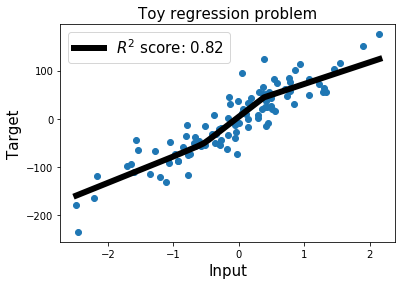
- TensorFlow 1.x 深度學習秘籍
- 零、前言
- 一、TensorFlow 簡介
- 二、回歸
- 三、神經網絡:感知器
- 四、卷積神經網絡
- 五、高級卷積神經網絡
- 六、循環神經網絡
- 七、無監督學習
- 八、自編碼器
- 九、強化學習
- 十、移動計算
- 十一、生成模型和 CapsNet
- 十二、分布式 TensorFlow 和云深度學習
- 十三、AutoML 和學習如何學習(元學習)
- 十四、TensorFlow 處理單元
- 使用 TensorFlow 構建機器學習項目中文版
- 一、探索和轉換數據
- 二、聚類
- 三、線性回歸
- 四、邏輯回歸
- 五、簡單的前饋神經網絡
- 六、卷積神經網絡
- 七、循環神經網絡和 LSTM
- 八、深度神經網絡
- 九、大規模運行模型 -- GPU 和服務
- 十、庫安裝和其他提示
- TensorFlow 深度學習中文第二版
- 一、人工神經網絡
- 二、TensorFlow v1.6 的新功能是什么?
- 三、實現前饋神經網絡
- 四、CNN 實戰
- 五、使用 TensorFlow 實現自編碼器
- 六、RNN 和梯度消失或爆炸問題
- 七、TensorFlow GPU 配置
- 八、TFLearn
- 九、使用協同過濾的電影推薦
- 十、OpenAI Gym
- TensorFlow 深度學習實戰指南中文版
- 一、入門
- 二、深度神經網絡
- 三、卷積神經網絡
- 四、循環神經網絡介紹
- 五、總結
- 精通 TensorFlow 1.x
- 一、TensorFlow 101
- 二、TensorFlow 的高級庫
- 三、Keras 101
- 四、TensorFlow 中的經典機器學習
- 五、TensorFlow 和 Keras 中的神經網絡和 MLP
- 六、TensorFlow 和 Keras 中的 RNN
- 七、TensorFlow 和 Keras 中的用于時間序列數據的 RNN
- 八、TensorFlow 和 Keras 中的用于文本數據的 RNN
- 九、TensorFlow 和 Keras 中的 CNN
- 十、TensorFlow 和 Keras 中的自編碼器
- 十一、TF 服務:生產中的 TensorFlow 模型
- 十二、遷移學習和預訓練模型
- 十三、深度強化學習
- 十四、生成對抗網絡
- 十五、TensorFlow 集群的分布式模型
- 十六、移動和嵌入式平臺上的 TensorFlow 模型
- 十七、R 中的 TensorFlow 和 Keras
- 十八、調試 TensorFlow 模型
- 十九、張量處理單元
- TensorFlow 機器學習秘籍中文第二版
- 一、TensorFlow 入門
- 二、TensorFlow 的方式
- 三、線性回歸
- 四、支持向量機
- 五、最近鄰方法
- 六、神經網絡
- 七、自然語言處理
- 八、卷積神經網絡
- 九、循環神經網絡
- 十、將 TensorFlow 投入生產
- 十一、更多 TensorFlow
- 與 TensorFlow 的初次接觸
- 前言
- 1.?TensorFlow 基礎知識
- 2. TensorFlow 中的線性回歸
- 3. TensorFlow 中的聚類
- 4. TensorFlow 中的單層神經網絡
- 5. TensorFlow 中的多層神經網絡
- 6. 并行
- 后記
- TensorFlow 學習指南
- 一、基礎
- 二、線性模型
- 三、學習
- 四、分布式
- TensorFlow Rager 教程
- 一、如何使用 TensorFlow Eager 構建簡單的神經網絡
- 二、在 Eager 模式中使用指標
- 三、如何保存和恢復訓練模型
- 四、文本序列到 TFRecords
- 五、如何將原始圖片數據轉換為 TFRecords
- 六、如何使用 TensorFlow Eager 從 TFRecords 批量讀取數據
- 七、使用 TensorFlow Eager 構建用于情感識別的卷積神經網絡(CNN)
- 八、用于 TensorFlow Eager 序列分類的動態循壞神經網絡
- 九、用于 TensorFlow Eager 時間序列回歸的遞歸神經網絡
- TensorFlow 高效編程
- 圖嵌入綜述:問題,技術與應用
- 一、引言
- 三、圖嵌入的問題設定
- 四、圖嵌入技術
- 基于邊重構的優化問題
- 應用
- 基于深度學習的推薦系統:綜述和新視角
- 引言
- 基于深度學習的推薦:最先進的技術
- 基于卷積神經網絡的推薦
- 關于卷積神經網絡我們理解了什么
- 第1章概論
- 第2章多層網絡
- 2.1.4生成對抗網絡
- 2.2.1最近ConvNets演變中的關鍵架構
- 2.2.2走向ConvNet不變性
- 2.3時空卷積網絡
- 第3章了解ConvNets構建塊
- 3.2整改
- 3.3規范化
- 3.4匯集
- 第四章現狀
- 4.2打開問題
- 參考
- 機器學習超級復習筆記
- Python 遷移學習實用指南
- 零、前言
- 一、機器學習基礎
- 二、深度學習基礎
- 三、了解深度學習架構
- 四、遷移學習基礎
- 五、釋放遷移學習的力量
- 六、圖像識別與分類
- 七、文本文件分類
- 八、音頻事件識別與分類
- 九、DeepDream
- 十、自動圖像字幕生成器
- 十一、圖像著色
- 面向計算機視覺的深度學習
- 零、前言
- 一、入門
- 二、圖像分類
- 三、圖像檢索
- 四、對象檢測
- 五、語義分割
- 六、相似性學習
- 七、圖像字幕
- 八、生成模型
- 九、視頻分類
- 十、部署
- 深度學習快速參考
- 零、前言
- 一、深度學習的基礎
- 二、使用深度學習解決回歸問題
- 三、使用 TensorBoard 監控網絡訓練
- 四、使用深度學習解決二分類問題
- 五、使用 Keras 解決多分類問題
- 六、超參數優化
- 七、從頭開始訓練 CNN
- 八、將預訓練的 CNN 用于遷移學習
- 九、從頭開始訓練 RNN
- 十、使用詞嵌入從頭開始訓練 LSTM
- 十一、訓練 Seq2Seq 模型
- 十二、深度強化學習
- 十三、生成對抗網絡
- TensorFlow 2.0 快速入門指南
- 零、前言
- 第 1 部分:TensorFlow 2.00 Alpha 簡介
- 一、TensorFlow 2 簡介
- 二、Keras:TensorFlow 2 的高級 API
- 三、TensorFlow 2 和 ANN 技術
- 第 2 部分:TensorFlow 2.00 Alpha 中的監督和無監督學習
- 四、TensorFlow 2 和監督機器學習
- 五、TensorFlow 2 和無監督學習
- 第 3 部分:TensorFlow 2.00 Alpha 的神經網絡應用
- 六、使用 TensorFlow 2 識別圖像
- 七、TensorFlow 2 和神經風格遷移
- 八、TensorFlow 2 和循環神經網絡
- 九、TensorFlow 估計器和 TensorFlow HUB
- 十、從 tf1.12 轉換為 tf2
- TensorFlow 入門
- 零、前言
- 一、TensorFlow 基本概念
- 二、TensorFlow 數學運算
- 三、機器學習入門
- 四、神經網絡簡介
- 五、深度學習
- 六、TensorFlow GPU 編程和服務
- TensorFlow 卷積神經網絡實用指南
- 零、前言
- 一、TensorFlow 的設置和介紹
- 二、深度學習和卷積神經網絡
- 三、TensorFlow 中的圖像分類
- 四、目標檢測與分割
- 五、VGG,Inception,ResNet 和 MobileNets
- 六、自編碼器,變分自編碼器和生成對抗網絡
- 七、遷移學習
- 八、機器學習最佳實踐和故障排除
- 九、大規模訓練
- 十、參考文獻
